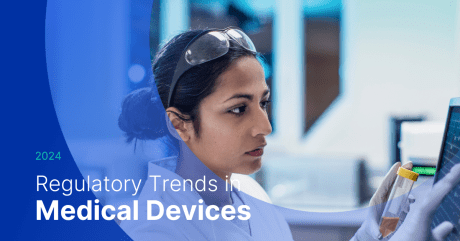
EU Regulation 2024/1860 on Eudamed: New Obligations and Updated Transitional Provisions for Certain In Vitro Diagnostic Medical Devices

This blog was originally posted on 16th July, 2024. Further regulatory developments may have occurred after publication. To keep up-to-date with the latest compliance news, sign up to our newsletter.
AUTHORED BY DENISE MCDERMOTT, SENIOR REGULATORY COMPLIANCE SPECIALIST, COMPLIANCE & RISKS
Introduction
On 9th July 2024, the EU Commission published Regulation (EU) 2024/1860 of the European Parliament and of the Council, amending Regulations (EU) 2017/745 and (EU) 2017/746 as regards a gradual roll-out of Eudamed, the obligation to inform in case of interruption or discontinuation of supply, and transitional provisions for certain in vitro diagnostic medical devices.
In this blog we look at EU Regulation 2024/1860 on Eudamed.
New Obligation to Inform In Case of Interruption or Discontinuation of Supply
As per Regulation (EU) 2024/1860, Regulation (EU) 2017/745 and (EU) 2017/746 are amended to incorporate the new manufacturer obligation to report any potential interruption or discontinuation of supply of certain devices.
When a manufacturer becomes aware of a potential interruption or discontinuation of the supply of a device, which is likely to cause harm, the manufacturer shall inform the relevant competent authority, economic operators, health institutions and healthcare professionals. This information shall be provided at least 6 months before the anticipated interruption or discontinuation.
Gradual Roll-out of Eudamed
EU Regulation 2024/1860 amends the provisions relating to the mandatory use of the European database on medical devices (Eudamed).
According to the regulation, the Commission shall inform the Medical Device Coordination Group (MDCG) after each module passes an independent audit and is verified to be functional. A notice will be published in the Official Journal of the EU (OJEU) stating that the module is functional and meets the required specifications.
An updated timeline on the roll out and modules’ functionality can be viewed on the European Commission website here.
Transitional Provisions for Certain In Vitro Diagnostic Medical Devices
The dates after which legacy devices may continue to be placed on the market have been extended, but only under certain strict conditions including;
- The devices continue to comply with Directive 98/79/EC;
- There are no significant changes in the design and intended purpose;
- The devices do not present an unacceptable risk to the health or safety;
- A quality management system has been put in place by 26 May 2025;
- A formal application has been lodged with a notified body by the applicable date;
- 26 May 2025 for class D,
- 26 May 2026 for class C,
- 26 May 2027 for class B and A sterile.
- A written agreement is in place with a notified body by the applicable date
- 26 September 2025 for class D,
- 26 September 2026 for class C,
- 26 September 2027 for class B and A sterile.
- If the above requirements are fulfilled, the transition period is extended to:
- 31 December 2027 for Class D devices
- 31 December 2028 for Class C devices
- 31 December 2029 for class B devices and for class A sterile
Certificates and Surveillance
Certificates issued by notified bodies in accordance with Directive 98/79/EC that have not been withdrawn shall continue to remain valid until 31 December 2027. Certificates that have expired before 9 July 2024 shall only be considered to be valid until 31 December 2027 if the manufacturer and a notified body have signed a written agreement in place or a competent authority has granted a derogation. Until 25 September 2025 the notified body that issued a certificate under the IVDD continues to be responsible for the relevant surveillance, or an arrangement can be made to transfer the surveillance to a notified body designated under the IVDR before 26 September 2025.
Overall, Regulation (EU) 2024/1860 aims to ensure a high level of patient safety and prevent any potential device shortages. It also enables a gradual roll-out of the Eudamed modules which will ultimately improve transparency and aid in the monitoring of availability of devices. Supporting sources including a Q&A on the new transition periods can be found here. This Q&A document also includes a flowchart in its appendix, to assist in deciding whether or not a device is covered by the extended transitional period.
References
- Regulation (EU) 2024/1860 of the European Parliament and of the Council of 13 June 2024 amending Regulations (EU) 2017/745 and (EU) 2017/746 as regards a gradual roll-out of Eudamed, the obligation to inform in case of interruption or discontinuation of supply, and transitional provisions for certain in vitro diagnostic medical devices, found here.
- European Commission supporting sources on Extension of the transition periods laid down in the regulations. See here.
- Updated Timeline – Current planning for gradual roll out and modules’ functionality view can be viewed on the European Commission website here.
Stay Ahead Of Regulatory Changes
Accelerate your ability to achieve, maintain & expand market access for all products in global markets with C2P – Your key to unlocking market access, trusted by more than 300 of the world’s leading brands.
C2P is an enterprise SaaS platform providing everything you need in one place to achieve your business objectives by proving compliance in over 195 countries.
C2P is purpose-built to be tailored to your specific needs with comprehensive capabilities that enable enterprise-wide management of regulations, standards, requirements and evidence.
Add-on packages help accelerate market access through use-case-specific solutions, global regulatory content, a global team of subject matter experts and professional services.
- Accelerate time-to-market for products
- Reduce non-compliance risks that impact your ability to meet business goals and cause reputational damage
- Enable business continuity by digitizing your compliance process and building corporate memory
- Improve efficiency and enable your team to focus on business critical initiatives rather than manual tasks
- Save time with access to Compliance & Risks’ extensive Knowledge Partner network
Medical Devices Regulatory Updates in North, Central and South America
This whitepaper gives an overview of recent medical device regulatory developments in North, Central and South America to help you keep your medical devices compliant.


